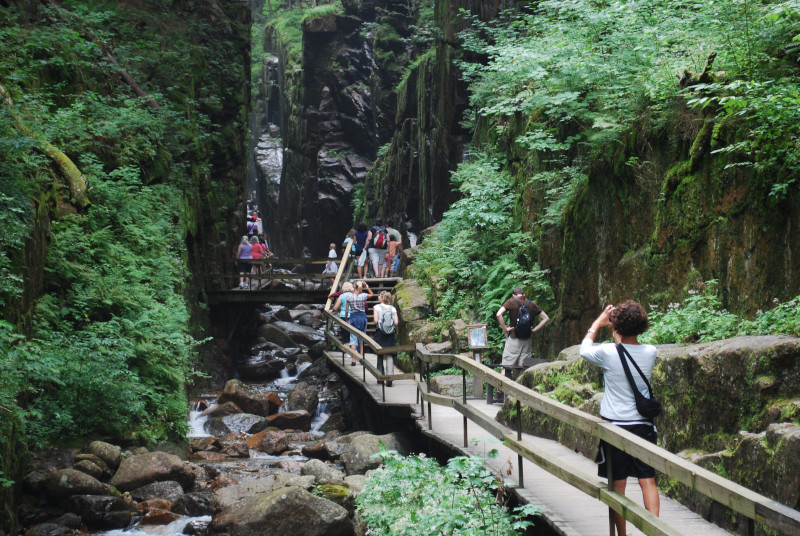Flume Gorge Facts
- The somewhat understated term of Flume Gorge serves as the name of a stunning, lesser-known natural geological formation. While not widely known outside of its immediate area, it nonetheless fully deserves its own degree of merit and appreciation.
- It’s currently not officially known if the local Native American population knew of its existence in past ages. That’s only due to a lack of formal information on the subject. Given their long-term presence in the area, though, it seems likely they knew of it.
- The first recorded discovery of the site by a non-native, however, took place in 1808. That’s because, at that time, an elderly, local resident settler came upon it accidentally, while fishing. The intrepid 93-year-old was known as “Aunt” Jess Guernsey.
- In modern times, the remarkable Flume Gorge understandably became a popular recreational destination among locals. Subsequently, the gorgeous location became part of a small protected site. That’s the lovely Franconia Notch State Park.
- Due to this, it’s now only viewable by paid visitors to the site. This allows for a modicum of protection for the feature, from the depredations of unattended visitors. Concerted efforts also remain underway to preserve the gorge in its pristine condition.
Related Articles
Flume Gorge Physical Description
The magnificent formation known simply as Flume Gorge perfectly proves a well-known observation about Nature. That’s the belief by some that natural forces place no importance on relative size when it comes to the amount of beauty imbued within them.
That statement’s true since this naturally formed canyon actually remains rather small, compared to many such features around the world. But it packs a lot into that small space. Indeed, its confines also contain several smaller features, themselves worthy of some note.
This natural small canyon extends comparatively straight for approximately 800 ft (240 m). Given its short length, its walls further rise to relatively great heights. This measurement varies along its length, however. These range in height from roughly 70 – 90 ft (21 – 27 m).
Breathtaking Flume Gorge isn’t for those few visitors who suffer from claustrophobia, though. That’s because it’s also quite narrow, considering its length. Across the totality of its length, the distance between the sides only ranges from about 12 – 20 ft (3.7 – 6.1 m)!
The location also boasts its own stunning, if small, waterfall. Appropriately named Avalanche Falls, this formed in recent times. That formation occurred due to the actions of a powerful storm in 1883. The cascade plunges 45 ft (13.6 m) at the entrance to the gorge.
Flume Gorge Location, Formation, and Ecology
Flume Gorge formed in a portion of the world known for its abundance on natural beauty. That’s due to the fact that it lies in a portion of the continent of North America. Though the region’s better known for its botanical beauty, it also hoasts geological ones as well.
More precisely, however, the wondrous site lies within the confines of the United States. There, its formation placed it in the far northeastern portion of the country. This geological masterpiece further sits near the base of Mount Liberty, in the state of New Hampshire.
It’s also surprisingly old. The origins of this work of geological forces reach all the way back roughly 200 million years. The specific rock of the region, known as Conway granite, began as deeply buried molten rock. This also broke into vertical fractures as it cooled.
Other forces of Nature subsequently acted to contribute to its formation. Erosion expanded the fractures, widening them. This led to water being allowed in, which further expanded the structure. Eventually, it reached the general dimensions it possesses at this time.
Due to its nature, few species make their home within the confines of Flume Gorge. Yet life always clings wherever it can. A scattering of trees managed to gain a foothold in cracks along the steep walls of the canyon. Moss and ferns also appear in scattered locations.
Because of the presence of the trees and ferns, a variety of locally prevalent insect species naturally appear as well. Various varieties of birds also make their homes in the branches of the trees. A handful of aquatic invertebrates and fish also live in the gently flowing stream.
Features Sharing Its Region
Check out our other articles on 5 Fantastic fauna of Tunisia, Giant Golden Orb Weaver, Kings Canyon, New Guinea Crocodile, Mountain Laurel, Hyacinth Macaw, Indian Bullfrog, Mugger Crocodile

